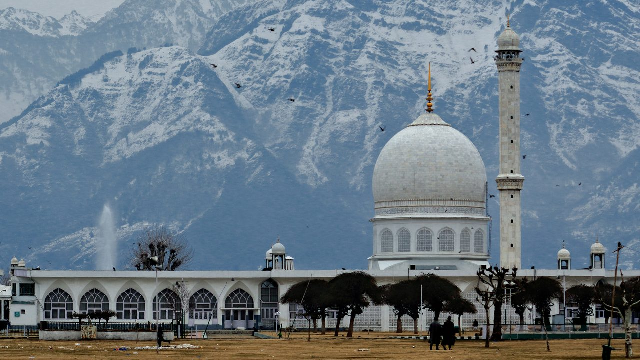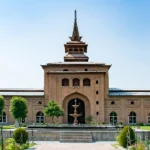Table of Contents
Toggle- Overview
- The Sacred Significance of Hazratbal Shrine
- Etymology of Hazratbal Shrine
- Architectural Grandeur of Hazratbal Shrine
- The Moi-e-Muqqadas: The Sacred Relic
- Hazratbal Shrine as a Cultural Symbol
- Pilgrimage in Hazratbal Shrine: the Devotion Feel
- How to Reach Hazratbal Shrine
- Best Time to Visit Hazratbal Shrine
- Conclusion: A Place of Devotion for All Visitors
- How to book Hazratbal Shrine Visit online?
- People Also Ask
- What is the Hazratbal Shrine?
- When was the Hazratbal Shrine built?
- Why is the Hazratbal Shrine important?
- Where is the Hazratbal Shrine located?
- What is the relic at Hazratbal Shrine?
- How do visitors reach the Hazratbal Shrine?
- What are the key rituals performed at Hazratbal Shrine?
- Can non-Muslims visit the Hazratbal Shrine?
- What is the significance of the Hazratbal Shrine in Kashmiri culture?
- What is the Hazratbal Mosque?
- What architectural style is the Hazratbal Shrine built in?
- When is the relic of Prophet Muhammad displayed?
- How is Hazratbal Shrine related to the Kashmir conflict?
- What is the significance of Dal Lake in relation to Hazratbal Shrine?
- What events take place at Hazratbal Shrine during Ramadan?
- Is Hazratbal Shrine a popular tourist destination?
- Are there any festivals celebrated at Hazratbal Shrine?
- What is the best time to visit Hazratbal Shrine?
- Can visitors take photographs at Hazratbal Shrine?
- What should visitors wear when visiting Hazratbal Shrine?
- What is the history behind the relic of Prophet Muhammad at Hazratbal Shrine?
- What is the Hazratbal Shrine’s connection to Kashmir’s religious diversity?
- How can I reach Hazratbal Shrine from Srinagar?
- What makes the Hazratbal Shrine stand out among other shrines in Kashmir?
- Can I visit Hazratbal Shrine during winter?
- Inquiry Form
Overview
The shrine of Hazratbal is no more a place for worship; in fact, this is a heritage site with considerable cultural and historic importance in the state of Jammu and Kashmir. It has majestically sat on northern banks of the Dal Lake, Srinagar, with every characteristic of forming some significant and even religious place for Kashmir, also attracting pilgrims as well as tourists. Hazratbal Shrine is always a symbol of the deeply rooted religious traditions of Kashmir with its serene environment, historical significance, and spiritual relevance. All aspects of Hazratbal Shrine, from history to architecture, religious significance, and experiences of visitors, will be covered in this blog.
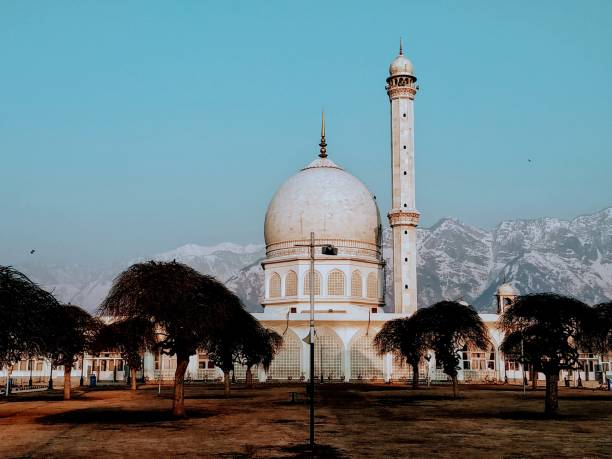
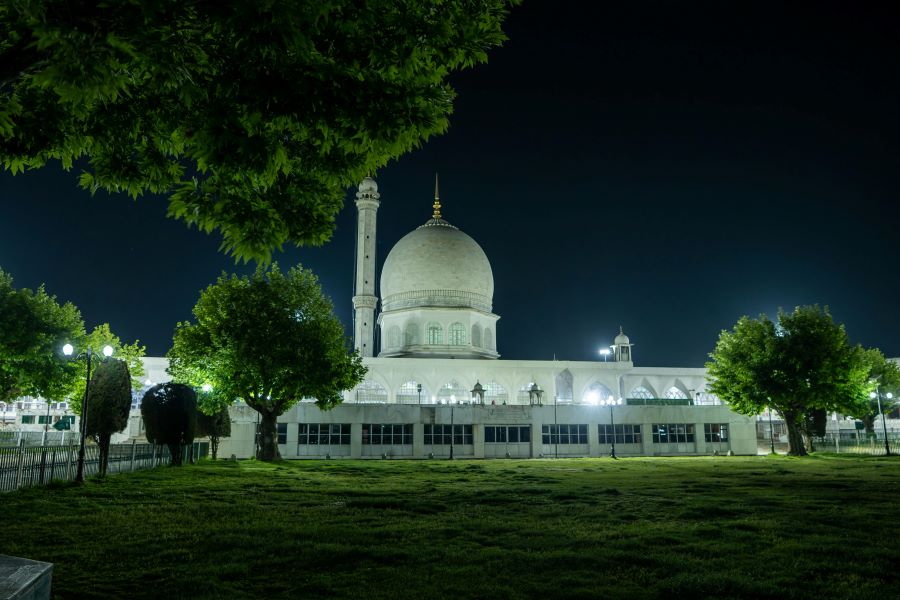
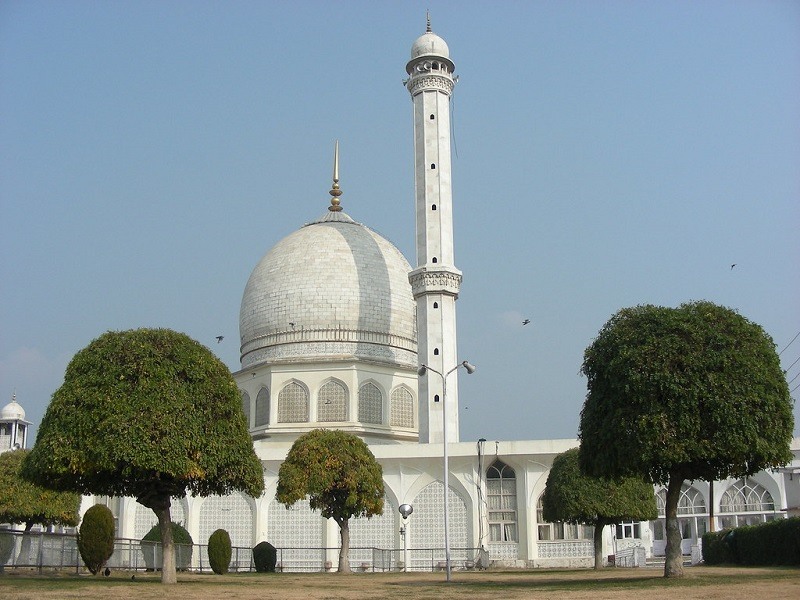
The Sacred Significance of Hazratbal Shrine
At the very core of Hazratbal Shrine lies the sacred importance attached by the Muslim fraternity, mainly from Kashmir, for the Moi-e-Muqqadas shrine, as the sacred hair relic of the Prophet Muhammad(PBUH) forms an important article in the collection of the revered hair relics kept under the holy shrines across the world. According to traditions, this sacred relic was brought from Central Asia and has since then been carefully preserved.
This relic has been considered a divine link between the Muslim community and the Prophet Muhammad(PBUH). While the history regarding the origin of this relic is still debated, its value in the tradition of Kashmiri Muslim culture remains unparalleled. According to tradition, the relic was brought to Kashmir by the prominent Sufi missionary Mir Shams-ud-Din Araki in the 14th century. Hazratbal Shrine is currently considered the focus of worship, prayer, and worship as the Moi-e-Muqqadas in Hazratbal Shrine remains as an important element of the Kashmiri Muslim faith and culture in preserving this revered relic to this day.
Etymology of Hazratbal Shrine
Hazratbal Shrine, in relation to its history and the establishment of Islam within this region, reflects a vital portion of Kashmir. The original version of the shrine was built during the 15th century under the rule of Sultan Zain-ul-Abidin. The original design was a minor one, essentially a simple sanctuary and shelter for worship. Successive reconstructions took place to the shrine throughout the Mughal period; these have really left an imprint on the architecture of Kashmir.
The most crucial developments to the shrine were when the Mughal rulers transformed it into a massive structure in the 18th century. Modern Hazratbal Shrine, that stands today is a construction based on the architectural style of the Mughal with white marble and exquisite wooden work symbolizing spiritual worship along with excellence in art. At this point of time, Moi-e-Muqqadas became housed within the shrine making its significance much greater.
Architectural Grandeur of Hazratbal Shrine
Hazratbal Shrine is a masterpiece of architectural grandeur. Beautiful white marble walls and a stunning dome catch the attention of people. Its design represents a blend of Islamic and Kashmiri styles, which makes this shrine different from others in Srinagar. The Himalayas are the background, and the serene Dal Lake provides an abode of peace surrounding the shrine.
This shrine mainly boasts of a huge dome that stands high amidst the serene surroundings. The marble walls of the shrine depict both artistic and spiritual aspects with intricate designs and calligraphy. The windows are carved out of wood in the traditional Kashmiri handicraft. There are minarets extending from its corners that create a majestic aura casting shadows on the landscape around the shrine.
The interior is not less than a wonder: there are tall ceilings and the great prayer hall could house a multitude of people. There is also an inner room, where the holy relic was kept, closed throughout most of the year but sometimes opened on some religious dates, so pilgrims could get a glimpse of it in all its holiness. The tranquil background and exquisite design of the shrine make it a place of worship and serenity, unmatched.
The Moi-e-Muqqadas: The Sacred Relic
The essence of Hazratbal Shrine lies in its connection to the Moi-e-Muqqadas-the sacred hair strand of Prophet Muhammad(PBUH). As such, it finds a direct line to the Prophet(PBUH) in Islamic thought, as an expression of an intense link that exists between heaven and earth. The preservation of the relic, and the exhibit at Hazratbal Shrine continue to stir in Muslims from Kashmir and other areas a sense of deep respect for the sacred strand.
It is imported from Central Asia. The present one has been owned by a number of persons before it landed in Hazratbal. It is shown to the public once in a year during special religious nights; the night of Shab-e-Meraj when Prophet Muhammad(PBUH) was taken to heaven, Eid-ul-Fitr and Eid-ul-Adha, when devotees from all over Kashmir, and even other places, visit Hazratbal Shrine to catch a glimpse of the Moi-e-Muqqadas.
The relic is enclosed in a glass case, so the devotees cannot move an inch to see it, which is a more exhilarating experience. The day is celebrated with special prayers, and thousands of people gather to pay their homage. For Kashmiri Muslims, Moi-e-Muqqadas is not only a relic but a symbol of faith, purity, and spiritual connection with the Prophet(PBUH).
Hazratbal Shrine as a Cultural Symbol
Hazratbal Shrine is more than a place of worship for it has great importance to the cultural psyche of people of Kashmir. It stands more as an indicator of identity with the culture and the religious value for Kashmiri Muslims and symbol of its grand past. Historically, countless events had gone down within these precincts in Hazratbal.
The shrine has also been used as a site for social and cultural events. During festivals, the Hazratbal locality turns into an enthusiastic locality. Here, all the pilgrims and local people come together to celebrate the religious festivals and greet each other while recalling the sanctity of the occasion. Both the mosque and the shrine are being made a witness to the changing politics and society of the region and still remain a symbol of peace and resistance.
This shrine also finds mention in the Kashmiri art, music, and poetry. It inspires many poets, writers, and artists through its beauty and serenity in the form of Hazratbal. One sees the beautiful scenes of Dal Lake with magnificent mountains around them while taking inspiration; the local poet uses a line to refer the shrine’s great depth in prayer. The connections have been deep when Hazratbal and Kashmir culture is concerned while being celebrated among art, music, and litrature for a long period now.
Pilgrimage in Hazratbal Shrine: the Devotion Feel
Visiting the Hazratbal Shrine is a pilgrimage in itself for people. For most people in the city, the Hazratbal shrine is the lifeline of religion. Many perceive the pilgrimage at Hazratbal Shrine as intensely personal and as an experience which cannot be told in words. People spend many hours praying and reflecting and soliciting blessings while standing within those silent walls.
It proves to be quite an opportunity to notice local customs of the region who are not closely familiar with these religious practices while visiting Hazratbal. Its deep spiritual significance among the people of Kashmir explains why the touristic crowd becomes spellbound under the serene surroundings, beautiful sights, and approach towards the shrine. Visitors are expected to keep the shrine pure by dressing modestly and joining in on the rituals when invited.
It is also a place of peace and solace for seeking spiritual guidance among the devotees. Many people spend hours on their knees asking for blessings not only for them but also their families. The peaceful call of prayer echoes throughout Dal Lake as the entire region is covered by this serenity.
How to Reach Hazratbal Shrine
Reaching Hazratbal Shrine is quite easy as it is situated at Srinagar, which is the summer capital of Jammu and Kashmir. The shrine lies on the northern banks of Dal Lake, a landmark that features the city. Here are the various ways to reach Hazratbal Shrine:
By Air: The nearest airport to Hazratbal Shrine is the Sheikh-ul-Alam International Airport in Srinagar. The airport is well connected to major Indian cities like Delhi, Mumbai, and Jammu. From the airport, visitors can hire a taxi or use local transport to reach the shrine.
By Train: Srinagar is well connected by rail to other major cities in India. The nearest railway station to Hazratbal is in Srinagar, and from there, visitors can hire a taxi or take an auto-rickshaw to the shrine.
By Road: Hazratbal Shrine is readily approachable from Srinagar through road. It is within a few kilometers from the center of the city. People can go there by their cars or on foot. One of the most beautiful ways to reach the shrine is by taking a ride on a shikara across Dal Lake.
Best Time to Visit Hazratbal Shrine
Summer season is the best season to visit the Hazratbal Shrine as it is warm, pleasant during the months of April to October, and therefore not too hot either. The landscape in and around the Dal Lake happens to be maximum in its splendor and thereby can be considered an excellent place for sight-seeing as well as a moment of spiritual solace.
It is the most active place of worship on Eid-ul-Fitr, Eid-ul-Adha, and Shab-e-Meraj. Thousands of devotees throng this place during the time of religious festivals to offer their respects. If you wish to see the religious fervor, it’s a good time to visit.
Winters are pretty cold there in Kashmir-from November to February. Though conditions might make many tourists lose interest, visitors lucky enough to find themselves seeing the shrine at that time experience a quiet and peaceful environment surrounding the shrine when it is less crowded.
Conclusion: A Place of Devotion for All Visitors
Hazratbal Shrine is more than a wonder of architecture; deep spiritual importance dwells within the shrine. It is a symbol of faith and devotion and full of history in itself for the Kashmiri Muslim. The place is sacred to them because inside its walls stands the sacred Moi-e-Muqqadas, which symbolically connects this community with the Prophet Muhammad. So, here pilgrims visit the shrine not only for some peaceful time full of history and architectural grandeur but also it is a haven, to see the beauty of Kashmir that it leaves deep impressions in one’s heart.
How to book Hazratbal Shrine Visit online?
Contact Brown Chinar at +91 6005039532/+91 9906188874 or Email us at : Enquiry@brownchinarkashmir.com
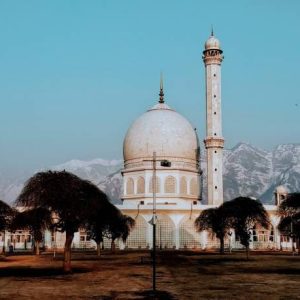
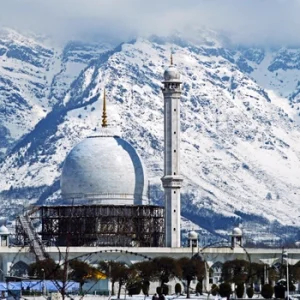
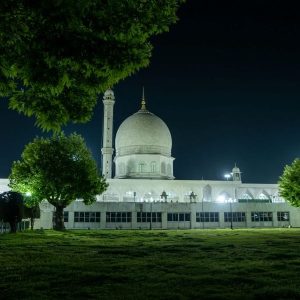
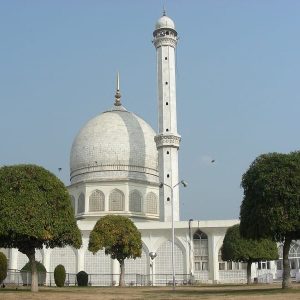
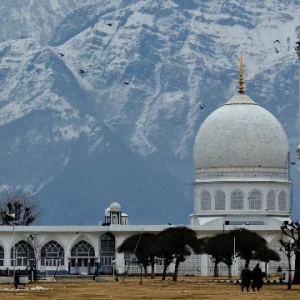
People Also Ask
What is the Hazratbal Shrine?
The Hazratbal Shrine is one of the most revered Muslim shrines in Kashmir, located on the northern shores of Dal Lake in Srinagar. It holds religious significance as it is home to a relic believed to be the hair strand of the Prophet Muhammad (PBUH).
When was the Hazratbal Shrine built?
The Hazratbal Shrine was built in 1634 AD during the reign of Sultan Zain-ul-Abidin. The shrine is a fine example of Kashmiri architecture and remains an important place of worship for Muslims in the region.
Why is the Hazratbal Shrine important?
The Hazratbal Shrine is considered highly sacred, primarily due to its reliquary, which contains a hair strand of Prophet Muhammad (PBUH). It is believed to have miraculous powers, attracting thousands of devotees, especially during religious occasions like Ramadan and Eid.
Where is the Hazratbal Shrine located?
The Hazratbal Shrine is located on the northern banks of Dal Lake, around 12 kilometers from the center of Srinagar, Kashmir. The site offers a beautiful view of the lake and the surrounding mountains.
What is the relic at Hazratbal Shrine?
The relic at Hazratbal Shrine is believed to be the hair strand of Prophet Muhammad (PBUH), which is kept in a glass container. This relic is considered one of the most sacred items for Muslims in Kashmir and is displayed to the public during specific religious events.
How do visitors reach the Hazratbal Shrine?
Visitors can reach the Hazratbal Shrine by boat from Dal Lake or by road. Boating is a popular choice as it offers a scenic route, with views of the lake and nearby hills. The shrine is also accessible via a short drive from central Srinagar.
What are the key rituals performed at Hazratbal Shrine?
Key rituals at the Hazratbal Shrine include prayers, offerings, and the displaying of the relic on certain religious occasions. Special prayers are conducted during the holy month of Ramadan, Eid, and other significant Islamic events.
Can non-Muslims visit the Hazratbal Shrine?
Yes, non-Muslims can visit the Hazratbal Shrine to witness its architectural beauty and learn about its religious significance. Visitors are expected to show respect for the religious practices observed at the shrine.
What is the significance of the Hazratbal Shrine in Kashmiri culture?
The Hazratbal Shrine holds a central place in Kashmiri culture, not just for Muslims but for the entire region. It is a symbol of religious harmony, cultural heritage, and devotion. The shrine serves as a place of spiritual reflection and peace.
What is the Hazratbal Mosque?
The Hazratbal Mosque is the prayer hall within the Hazratbal Shrine complex. It is an important place for Muslims to offer prayers and listen to religious sermons. The mosque is known for its magnificent architecture and peaceful atmosphere.
What architectural style is the Hazratbal Shrine built in?
The Hazratbal Shrine is built in Kashmiri Islamic architectural style, with wooden beams, marble flooring, and intricate designs. The structure includes Islamic calligraphy and other symbolic elements that contribute to its aesthetic value.
When is the relic of Prophet Muhammad displayed?
The relic of Prophet Muhammad (PBUH) is displayed on special occasions, including Eid-ul-Fitr, Eid-ul-Adha, and the 10th of Muharram (Ashura). The relic is shown to the public for a brief period and is highly venerated by visitors.
How is Hazratbal Shrine related to the Kashmir conflict?
The Hazratbal Shrine has been at the heart of various political and religious movements during the Kashmir conflict. The shrine has been a symbol of Kashmiri Muslim identity and has seen multiple protests and events that reflect the political situation in the region.
What is the significance of Dal Lake in relation to Hazratbal Shrine?
Dal Lake, where the Hazratbal Shrine is located, adds to the serenity and spiritual experience of the site. The lake’s beauty and calm waters create an ideal setting for reflection and prayer, making it an integral part of the shrine’s spiritual ambiance.
What events take place at Hazratbal Shrine during Ramadan?
During Ramadan, the Hazratbal Shrine witnesses large gatherings for night prayers (Taraweeh), special recitations of the Quran, and the display of the sacred relic. It is a time for reflection, devotion, and community prayers.
Is Hazratbal Shrine a popular tourist destination?
Yes, the Hazratbal Shrine is a major tourist destination in Srinagar, attracting visitors due to its religious significance and the picturesque location by Dal Lake. The peaceful environment and spiritual importance make it a key spot for both pilgrims and tourists.
Are there any festivals celebrated at Hazratbal Shrine?
The Hazratbal Shrine celebrates several Islamic festivals, including Eid-ul-Fitr, Eid-ul-Adha, and Milad-un-Nabi (the birth anniversary of Prophet Muhammad). These festivals see increased religious activity, prayers, and special events at the shrine.
What is the best time to visit Hazratbal Shrine?
The best time to visit the Hazratbal Shrine is during the summer months, from May to September, when the weather is pleasant. However, the shrine attracts a large number of visitors during Ramadan and Eid.
Can visitors take photographs at Hazratbal Shrine?
Photographs are typically not allowed inside the prayer hall of the Hazratbal Shrine out of respect for the religious practices. However, visitors can take pictures of the exterior of the shrine and the surrounding area of Dal Lake.
What should visitors wear when visiting Hazratbal Shrine?
Visitors are advised to dress modestly when visiting the Hazratbal Shrine, as it is a place of worship. Women, in particular, should cover their heads with scarves, while men should avoid wearing shorts.
What is the history behind the relic of Prophet Muhammad at Hazratbal Shrine?
The relic is believed to have been brought to Kashmir by Syed Abdullah in the 17th century. Since then, it has been kept at the Hazratbal Shrine and has become a significant religious symbol for Muslims in Kashmir.
What is the Hazratbal Shrine’s connection to Kashmir’s religious diversity?
The Hazratbal Shrine is a symbol of religious diversity in Kashmir. It serves as a place where people from various religious backgrounds can come together to witness the unity and shared culture of Kashmir, despite political and social differences.
How can I reach Hazratbal Shrine from Srinagar?
Hazratbal Shrine is about 12 kilometers from the city center of Srinagar. You can reach the shrine by car, taxi, or a boat ride on Dal Lake. The boat ride is particularly scenic and offers a peaceful journey to the shrine.
What makes the Hazratbal Shrine stand out among other shrines in Kashmir?
The Hazratbal Shrine stands out due to its unique relic, the hair strand of Prophet Muhammad (PBUH), and its picturesque location by Dal Lake. The serene environment and its historical importance make it one of the most significant religious sites in Kashmir.
Can I visit Hazratbal Shrine during winter?
Yes, the Hazratbal Shrine can be visited during the winter months, although the region experiences cold weather and snowfall. The shrine remains open year-round, but it is recommended to check the weather conditions before planning a visit during the colder months.

